
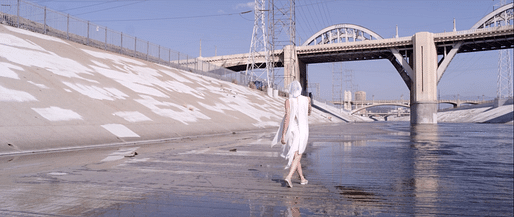
These days, it’s hard to think clearly about the Los Angeles River. Once the lifeline of the city and, before that, the Tongva people, the river was paved in the early 20th century following a series of devastating floods and then – at least according to a well-worn narrative – forgotten by the public.
After years of potamic amnesia, or so the story goes, Los Angeles suddenly remembered its river, finding in the thin stream a possible answer to both its growing thirst and perpetual identity crises. Now, nobody seems to talk about much else besides “our forgotten river”. In a sense, the LA River is the ecological inverse of Kim Kardashian: famous for being not-famous.
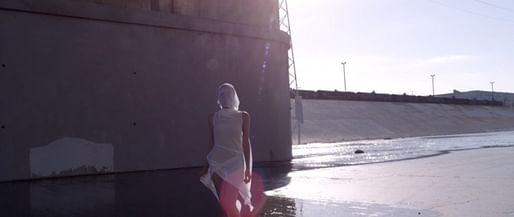
Of course, endless editorializing belies this apparent obscurity. It wasn’t just Frank Gehry’s arrival that heralded the return of the LA River to public attention, or the concatenation of activists and designers that preceded him. In a way, it had never really been forgotten at all. After all, the river has appeared in Hollywood classics, from Grease to the Italian Job, and countless music videos and commercials – not to mention serving as an integral part of the daily lives of many Angeleños, such as the residents of nearby Boyle Heights or Skid Row.
The problem was that, in these cases, the river appears as itself, which is to say, unapologetically unnatural: graffiti-adorned concrete slopes, heroic WPA-era bridges, and other markers of human infestation. That the specter of a more biologically-rich, better-managed, and more-attractive river has been conjured is undeniably a good thing – but it’s not the only ghost in town.
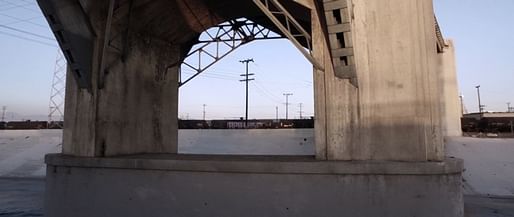
Enter Gharnasi, a duo of architects-turned-filmmakers, and their new “experimental documentary” 6 that endeavors to capture the spirit of the Sixth Street Viaduct, which spanned the LA River from 1932 until last weekend. Famed for its Deco design, the bridge was afflicted with what’s known colloquially as “concrete rot,” in short, a degenerative condition that rendered it structurally vulnerable. In an earthquake prone-city, that’s not a worth risk taking, and the bridge was demolished to make room for a new, decidedly more river-oriented one designed by Michael Maltzan.
According to the filmmakers, the initial seed for the film germinated in 2013, after an unexpected encounter with “King Monster,” a local homeless man who acts as the “gatekeeper” of the adjacent Seventh Street Bridge. He served as an informal guide to the bridges, and the duo developed a relationship with him that persisted.
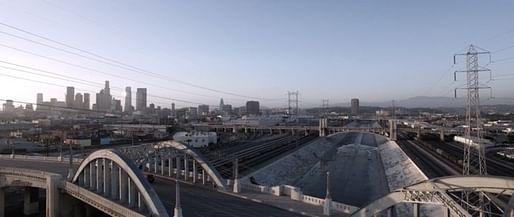
Flash forward to late last year, when the LA Forum hosted an event to mark the closing of the Sixth Street Viaduct including a video screening curated by Jai & Jai Gallery. In just six weeks and with virtually no budget, Gharnasi whipped together the short with King Monster providing the narration. With its slick production value, you’d never guess the film was under-funded or quickly-realized.
The protagonist of the short film is clearly the bridge, personified as a veil-clad female spirit (played by Breanna Box) locked in conversation with King Monster. Translating a piece of infrastructure into a character isn’t an easy task and the very idea of it speaks to the duo’s architectural background. “Constructing architecture is directly correlated with constructing a film, and vice versa,” they assert.
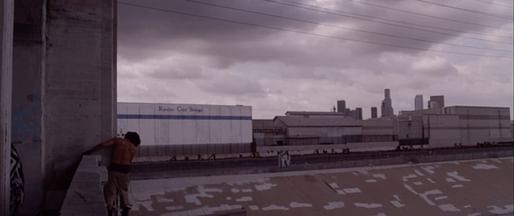
Unlike with other narratives of the LA River, here the object of nostalgia and remembrance is the very thing that most bemoan: the concrete and steel artifice of its 20th century existence. The ethos is a bit in keeping with the spirit of Frank Gehry’s controversial suggestion to maintain the river’s hardscape, or at least a more nuanced discussion of the relationship between a city and its non-human elements than the picturesque fantasy of a “return to nature” espoused by some.
“The world is an ever-changing and ongoing narrative, essentially a film with no end, the buildings act as both protagonist and antagonist, and us the people serve as the extras, constantly roaming around from one set to the next,” states Gharnasi. “Buildings are characters, they’re born, they live and they die, we just don’t notice them as much due to their static and repetitive state.”
6 certainly has a few questionable elements – the choice to personify the bridge in a decidedly sexualized fashion chief among them for me – but as a poetic intervention into an all-too-concretized narrative, and for it’s frankly beautiful imagery, it more than merits a gander.
Watch 6 here:
No Comments
Block this user
Are you sure you want to block this user and hide all related comments throughout the site?
Archinect
This is your first comment on Archinect. Your comment will be visible once approved.